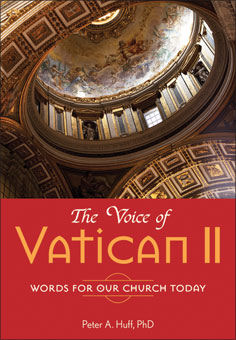
|
Posted
October 8, 2012
Book: The Voice of Vatican II: Words for our church today Author: Peter A. Huff, Ph.D. Liguori, Liguori Missouri. 2012. pp. 80 An Excerpt from the Jacket:
"The pilgrim departs a great cathedral rejuvenated," Huff writes, "What awaits the sincere reader of the Vatican II texts is a life-changing encounter with the living Church and the Church's living Lord." An Excerpt from the Book: Lay People Vatican II's final decree on service and vocation completes our tour of the nave, the cathedral's great midsection. Its topic --- the laity from (from the Greek word, laos, "people") --- sets Vatican II apart from all other councils in Christian history. No other council has ever given so much and so positive attention to the role of lay people. According to the Decree on the Apostolate of the Laity, every baptized Catholic is a full member and a responsible member of "God's own people" (1 Peter 2:9) The council's appreciation for the lay apostolate is one of its most distinctive features. An emphasis on the mission of lay people characterized Vatican II from the beginning. Early enthusiasm regarding "active participation" in the liturgy (SC14) was a sign of more to come. Lumen Gentium's sections on "The People of God" and "The Laity" celebrated the dignity of the "common priesthood of the faithful" (LG10), the family as a "domestic Church" (LG11), the laity's sense of the faith (LG 12, 35), and the "special vocation" of the laity to be the "salt of the earth: (LG33). Laymen and women served as auditors at the council, and Vatican II was the first council in history to invite a lay speaker to address the assembly. The council's Decree on the Apostolate of the Laity challenges conventional notions of lay responsibility. Catholic folklore reduces the layman's obligations to three: pray, pay, and obey. The decree sets a much higher standard. It links the lay disciple directly to the threefold task of the Savior: the "priestly, prophetical and kingly office of Christ" (AA2). Lay people possess the "right and duty to be apostles: (AA 3). Their mission is the mission of the Church: to take Christ into the world. Lay people should participate in, and in some cases lead, the world. Lay people should participate and in some cases lead, the Church's work in education, evangelization, apologetics (defending the faith), and the "renewal of the temporal order" (AA7). As believers and citizens, they should always be guided by a "single conscience, a Christian conscience" (AA5) and should never become "slaves" of modern science and technology (AA7). Male and female, young and old, married and single, all Catholics are invited to think creatively about their potential as "messengers of Christ" in the world (AA 14). Table of Contents: The story of Vatican II The renewal of Catholic worship Revelation of the living God The revival of Catholic identity Catholic ministry and vocation The church and the world The church in mission and dialogue Conclusion |
|
